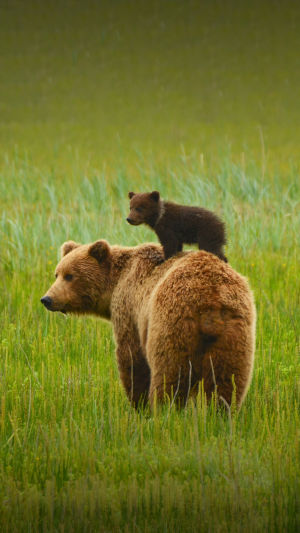Brown bears are members of the carnivore order and bear family. It is one of the largest terrestrial carnivorous mammals.
The brown bear is 1.5 to 2.8 meters tall and 0.9 to 1.5 meters high at the shoulder. Males weigh 135 to 545 kilograms and females weigh 80 to 250 kilograms.
The head is large and round, the body is strong. The coat is thick and dense, which is up to 10 cm in winter. The fur has different colors, such as gold, and brown.
The forearms are very powerful, and the tips of the forepaws are as long as 15 centimeters. Since the tips cannot be retracted into the claw sheath as cats can, they are relatively blunt. The forearms are powerful in the swing, and the claws can do a lot of damage.
Brown bear mainly inhabits the cold temperate coniferous forest, mostly active in the daytime. Walking slowly, with no fixed habitat, usually alone.
During hibernation, the frequency of body temperature, heart rate, excretory system, and respiration will decrease and slow down to reduce the loss of heat and calcium and prevent hypothermia and osteoporosis.
It can run at a speed of 56 kilometers per hour. During hibernation, one to four cubs are born. In spring, female bears often take cubs to play in the forest.
Brown bears will eat plants including all kinds of roots, tubers, grasses, grains, and fruits, and like to eat honey. And they will eat the animals including ants, ant eggs, insects, rodents, ungulates, fish, and carrion. It is found in Eurasia and much of North America.
Brown bears are thought to have evolved from Ursus Etruscans in Asia. The oldest fossils definitively identified as the species appear in China, about 500,000 years ago.
Brown bears entered Europe about 250,000 years ago and soon after into North Africa. Remains of brown bears from the Pleistocene period are common in the British Isles and it is thought that they may have trumped Ursus spelaeus.
The species entered Alaska 100,000 years ago, although they didn't move south until 13,000 years ago.
Instead of hibernating when food is plentiful, brown bears hunt all winter long. But when food is scarce, the bears spend the winter hiding in their burrows.
Brown bears' body temperature drops about four degrees during hibernation, but their heart rate slows by 75 percent. When brown bears begin hibernation, their energy sources switch from diet to stored fat.
When fat is burned, its metabolism produces toxins. Cells break down the toxins into harmless substances for recycling.
Although brown bears are omnivorous like all bears, their favorite food is honey.
Brown bears eat very mixed food, some food is not easy to digest. Honey can promote digestion and absorption, and improve the bear's immunity so that their body energy is quickly replenished.
When brown bears enter hibernation, they must rely on their body fat to be converted into energy to sustain their physical needs. Of all the nutrients, sugar is the easiest to turn into fat, so the bears naturally love honey.





